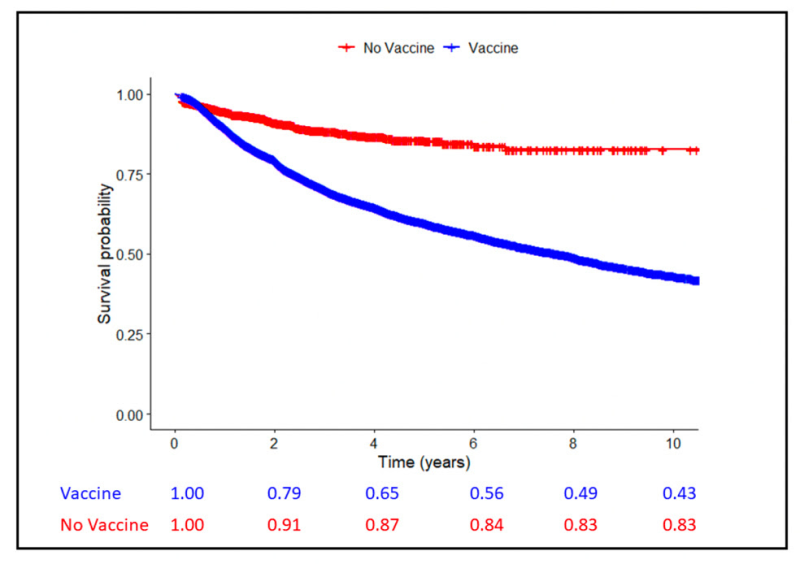Inside the Henry Ford Vaccine Controversy

By Maryanne Demasi, PhD, Brownstone Institute
When an unpublished study from one of America’s most respected hospital networks surfaced in the US Senate last month, it reignited a fierce debate in medicine: are vaccinated children healthier than unvaccinated children?
The study, titled “Impact of Childhood Vaccination on Short- and Long-Term Chronic Health Outcomes in Children,” was introduced into the Congressional Record on 9 September 2025 during a Senate hearing on “The Corruption of Science.”
Attorney Aaron Siri, who specialises in vaccine-related litigation, told lawmakers the research had been completed in 2020 by scientists at Henry Ford Health, but never published.
The reason, he said, was fear.
“These were mainstream, pro-vaccine scientists,” said Siri. “But when their analysis showed higher rates of chronic illness among vaccinated children, they were warned that publishing it could cost them their jobs.”
Once uploaded to the Senate website, the results were public—and damning. The Henry Ford team found vaccinated children had far higher rates of chronic disease than their unvaccinated peers.
The reaction was swift.
Vaccine defenders dissected the study line-by-line, accusing its authors of methodological errors and “fatal flaws.” Henry Ford Health itself issued a statement calling the paper from its own infectious-disease chief “unreliable.”
This analysis looks at the study, the controversy, and the criticism—and why this single dataset has become a lightning rod in the debate over scientific integrity.
Not a ‘Fringe’ Lab
Henry Ford Health is not a rogue institution. It’s a century-old teaching hospital with over 30,000 staff, affiliated with Wayne State University, and known for pioneering research in infectious disease and public health.
The lead investigator, Dr Marcus Zervos, is a veteran infectious-disease specialist. During the Covid-19 pandemic, he was a regular on local news programs, promoting vaccination and defending public-health mandates.
His involvement gave the project an establishment credibility rarely seen in vaccine-safety research.
Zervos and his colleagues agreed to perform a comprehensive comparison of vaccinated versus unvaccinated children using the health system’s electronic medical records.
For years, the Institute of Medicine had urged the CDC to conduct such a study using its Vaccine Safety Datalink. It never did. So, Henry Ford’s data scientists decided to test the claim themselves.
What They Found
The researchers analysed records for 18,468 children born between 2000 and 2016. Of these, 16,500 had received at least one vaccine, while 1,957 were completely unvaccinated.
They tracked both groups for up to ten years, looking for chronic conditions—autoimmune, allergic, respiratory, neurodevelopmental, and metabolic disorders.
The headline result: vaccinated children had 2.5 times the rate of “any chronic disease.”
The risk was four times higher for asthma, three times higher for atopic conditions like eczema and hay fever, and five to six times higher for autoimmune and neurodevelopmental disorders.
After 10 years of follow-up, 57% of vaccinated children had developed at least one chronic condition, compared with just 17% of the unvaccinated children.

Notably, the study did not find higher rates of autism, though case numbers were too small to draw meaningful conclusions.
Overall, the authors concluded that vaccine exposure was associated with an increased risk of chronic disease.
The study wasn’t perfect; none of these large retrospective studies are.
The authors acknowledged potential confounding factors—unequal follow-up times, and the likelihood that vaccinated children, who see doctors more often, were more likely to be diagnosed.
To address this, they performed multiple sensitivity analyses, including restricting the sample to children followed for at least one, three, and five years, and excluding those with minimal visits.
But even after these corrections, the risk ratios “remained materially unchanged.”
On paper, it was the kind of observational study that routinely appears in top journals—a standard retrospective cohort using familiar statistical tools like Cox regression and Kaplan–Meier survival analysis.
But this time, the results challenged the narrative. The researchers knew that submitting it for peer review could end their careers.
Why The Study Was Buried
According to Siri’s Senate testimony, the Henry Ford team had promised to publish the paper regardless of the outcome.
But when the results came in, Zervos and his colleagues hesitated. Siri said they confided that publishing it would “make doctors uncomfortable.”
Those behind-the-scenes discussions were later captured in a new documentary that exposed the drama in full.
In a secretly recorded dinner conversation featured in the documentary An Inconvenient Study, Zervos is seen wrestling with the dilemma. “It’s the right thing to do,” he says, “but I just don’t want to.”
Henry Ford Health, scrambling to contain the fallout, threw Zervos under the bus, later claiming the paper was not published because it “did not meet the rigorous scientific standards required of our institution.”
But the methods—standard epidemiology applied to real-world data—were no different from those used in many of Henry Ford’s own published studies.
The Critics
At the Senate hearing, the fiercest attack came from Dr Jake Scott, an infectious-disease physician at Stanford, who dismissed the Henry Ford study as “flawed by design.”
He told senators it was “statistically impossible” that nearly two thousand unvaccinated children could have zero ADHD cases, calling it proof of diagnostic bias.
Scott argued that vaccinated children had “twice the follow-up time” and “many more doctor visits,” which, he said, made them appear sicker simply because they were observed more closely.
Siri pushed back, explaining that the Henry Ford researchers had already accounted for those issues. As stated in the study, they performed multiple adjustments for follow-up time and health-care utilisation, and the associations persisted.
When that failed to quiet critics, reinforcements arrived.
Professor Jeffrey Morris, head of biostatistics at the University of Pennsylvania and a prominent defender of vaccine orthodoxy on social media, published a detailed critique in The Conversation.
He accused the Henry Ford team of “elementary design errors” that made the findings “essentially uninterpretable.” In essence, Morris repeated Scott’s arguments.
He said vaccinated children were followed longer—“about 25 percent of unvaccinated kids were followed for less than six months, while 75 percent of vaccinated kids were followed beyond 15 months”—creating what he described as “surveillance bias.”
“When one group is watched longer and into the ages when problems are usually found,” he wrote, “they will almost always look sicker on paper.”
He also pointed to “detection bias,” noting that vaccinated children averaged seven doctor visits a year versus only two among the unvaccinated.
“The longer timeline and higher visit frequency,” he wrote, “gave vaccinated kids many more chances to have diagnoses recorded.”
Even the authors’ attempts to correct for this—limiting analysis to children followed beyond ages one, three or five—didn’t, in his view, “fix the imbalance.”
Finally, he highlighted confounding factors such as race, birthweight, prematurity, maternal complications, and unmeasured variables like income, environment, and access to care.
“When too many measured and unmeasured differences line up,” Morris wrote, “the study is unable to fully separate cause from effect.”
His conclusion was emphatic: “The differences reported in the study do not show that vaccines cause chronic disease.”
The Double Standard
Both Morris and Scott know the Henry Ford researchers openly acknowledged every limitation—and adjusted for them as best they could with further analyses. This is standard practice in observational science.
The problem isn’t that the critics raised potential biases; it’s that they applied their scrutiny unevenly.
When observational studies favour vaccination, those same flaws are quietly overlooked.
A recent example was the hyped claim that the HPV vaccine reduces cervical cancer rates—all based on the same kind of prospective data.

Even during the Covid-19 pandemic, the CDC and major journals relied almost entirely on retrospective data to claim that Covid vaccination was safe in pregnancy and that the shots “saved millions of lives.”
Those studies suffered from the same issues—confounding, incomplete follow-up, and selection bias—yet they were treated as conclusive. Not a word of criticism from the likes of Morris or Scott.
Neither of them called those papers “flawed by design” nor wrote opinion pieces about why those studies were untrustworthy.
But when a mainstream hospital study finds the opposite—that vaccination might correlate with poorer outcomes—the methodological nitpicking becomes forensic.
The double standard is unmistakable.
Why These Studies Never Get Done
Vaccine safety research is almost entirely funded by government agencies or manufacturers, both of which have a vested interest in maintaining confidence in the vaccine.
Proposing a study that might challenge that confidence is a career-limiting move.
That problem traces back to 1986, when the US Congress passed the National Childhood Vaccine Injury Act. The law granted vaccine manufacturers immunity from civil liability for vaccine injuries, effectively removing the financial incentive to rigorously study long-term safety.

With legal risk eliminated, commercial and regulatory scrutiny declined, and the burden of oversight shifted entirely to the same agencies that promote the products.
The Henry Ford project was unusual precisely because it came from within the establishment. It wasn’t conducted by activists, but by scientists who believed they were reinforcing the safety narrative.
It’s only when the data pointed the other way did the system leave them with no safe path to publication.
Peer-reviewed journals, wary of reputational fallout, rarely touch such work. Editors will cite “methodological concerns,” even when similar studies—often with far weaker data but politically safer conclusions—are published routinely.
Editors know it’s better to reject the controversy than risk the backlash.
What the Data Mean
None of this means the Henry Ford study “proves” vaccines cause chronic illness.
In fact, the authors were explicit about that. Correlation is not causation. But the magnitude of the differences—two- to six-fold higher risks across multiple diagnostic categories—warrants further scrutiny.
If the findings were artefacts of bias, then replication should quickly refute it. But rather than attempt replication, the response has been silence or derision.
Siri has challenged other large health systems, such as Kaiser Permanente and Harvard Pilgrim, and even the CDC’s Vaccine Safety Datalink, to repeat the analysis. So far, no one has stepped forward.
Even sceptics should want this question settled.
Chronic disease now affects more than half of American children. Asthma, allergies, autoimmune disorders, and neurodevelopmental diagnoses have surged over the past three decades—the same period that saw the largest expansion of the childhood immunisation schedule in history.
Perhaps that’s a coincidence. More likely, it’s multifactorial—pollution, diet, chemicals, antibiotics. But ruling out any possible contribution from vaccination without honest investigation is just reinforcing dogma.
The Film—An Inconvenient Study
Produced by Del Bigtree, it chronicles the secret recordings, the moral conflict of the researchers, and the institutional fear surrounding vaccine science.
It portrays Zervos not as a sceptic but as a man torn between conscience and career. “If I publish this,” Zervos confides, “I might as well retire. I’d be finished.”
Henry Ford Health’s decision not to publish may have been predictable, even rational, from a bureaucratic perspective. Publishing would have triggered a media storm, loss of funding, and professional ostracism for its authors.
But the ethical cost is harder to quantify. Suppressing inconvenient data corrodes public trust far more than open debate ever could.
The film ends with a challenge: if the data are flawed, replicate the study properly and prove it wrong. So far, no health agency has taken up that invitation.
Here lies the real paradox of modern science: when data affirm institutional narratives, they’re hailed as “robust real-world evidence.”
When they challenge them, they’re dismissed as “deeply flawed observational studies.” The standards don’t change—only the direction of the result does.
This asymmetry isn’t unique to vaccines. It pervades nutrition, psychiatry, cardiology—any field where corporate or ideological stakes are high. But in vaccine science, the consequences are amplified by politics, media, and fear.
That’s what paralysed the Henry Ford scientists. They weren’t activists or contrarians. They were establishment doctors who discovered that, in today’s climate, certain truths are simply too dangerous to tell.
They performed the kind of analysis public-health agencies have long said was needed—and when it yielded an unwelcome result, they shoved it in a drawer.
Perhaps that’s why a film had to be made…because when medical institutions silence dissent, storytelling has become the last refuge of truth.
The question for me is not whether the Henry Ford researchers were right or wrong, but why science has to continually punish curiosity.

Maryanne Demasi, 2023 Brownstone Fellow, is an investigative medical reporter with a PhD in rheumatology, who writes for online media and top tiered medical journals. For over a decade, she produced TV documentaries for the Australian Broadcasting Corporation (ABC) and has worked as a speechwriter and political advisor for the South Australian Science Minister.
Republished from the author’s Substack
and published here under a Creative Commons Attribution 4.0 International License. For reprints, please set the canonical link back to the original Brownstone Institute Article and Author.


.jpg)

